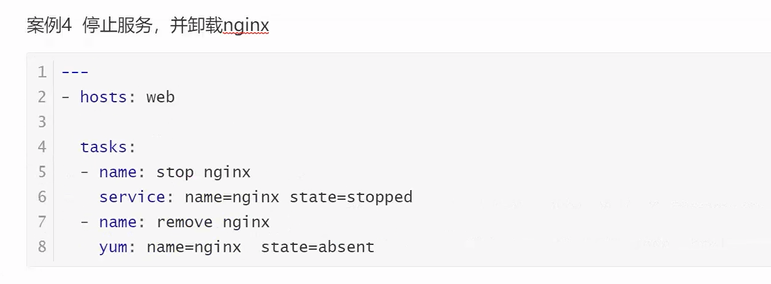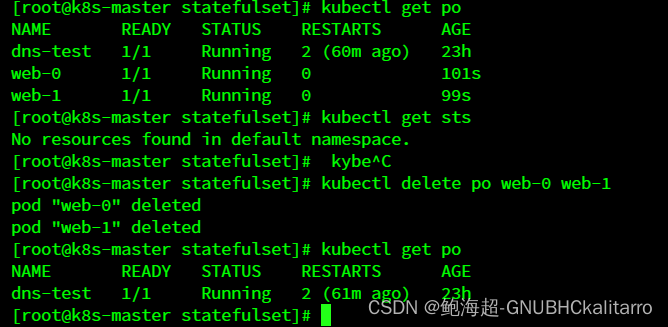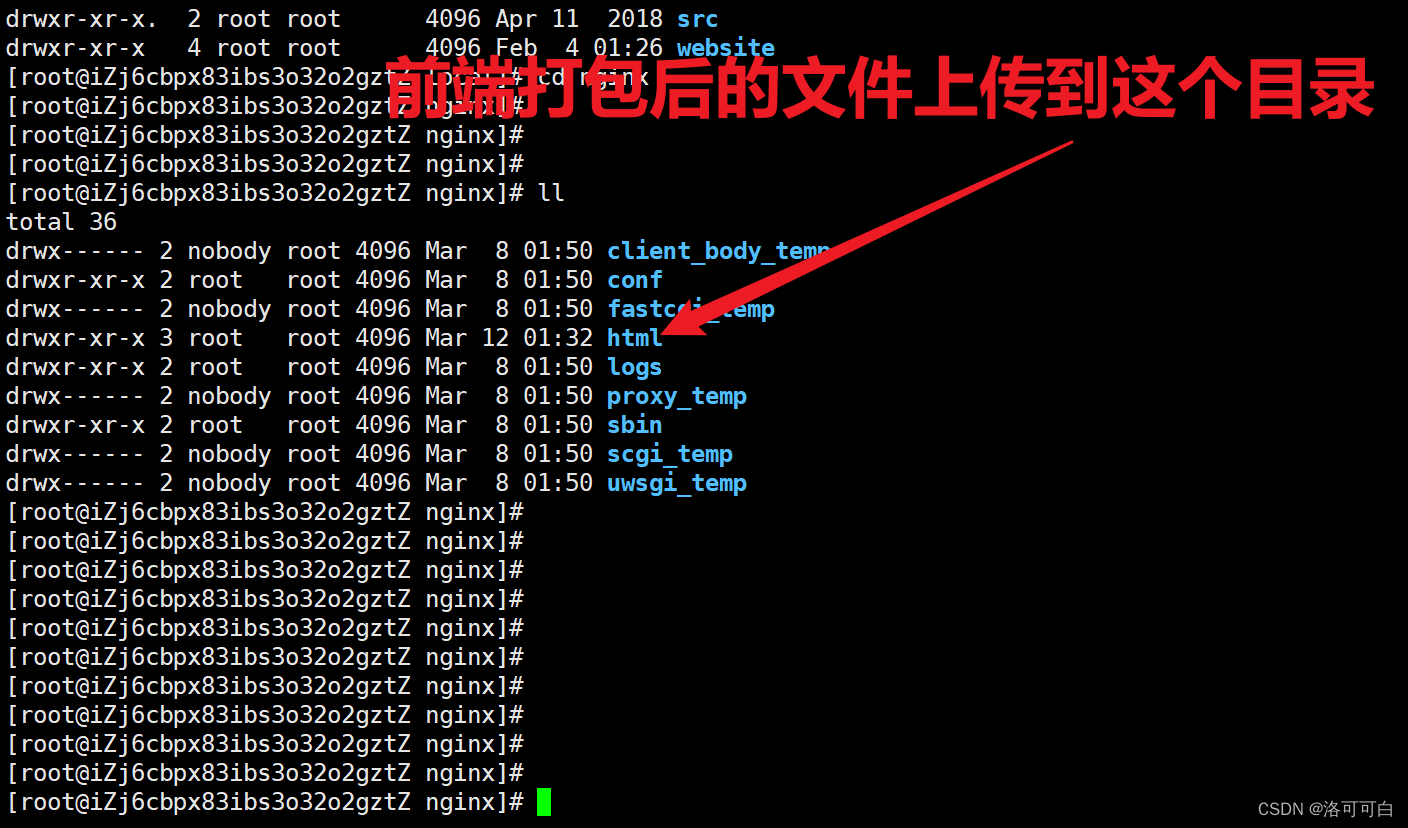前言运维自动化
云计算核心职能
-
搭建平台架构
-
日常运营保障
-
性能效率优化
相关工具
-
代码管理(SCM):GitHub、GitLab、BitBucket、SubVersion
-
构建工具:maven、Ant、Gradle
-
自动部署:Capistrano、CodeDeploy
-
持续集成(CI):Jenkins、Travis
-
配置管理:Ansible、SaltStack、Chef、Puppet
-
容器:Docker、Podman、LXC、第三方厂商如AWS
-
编排:Kubernetes、Core、Apache Mesos
-
服务注册与发现:Zookeeper、etcd、Consul
-
脚本语言:python、ruby、shell、go
-
日志管理:ELK、Logentries
-
系统监控:Prometheus、Zabbix、Datadog、Graphite、Ganglia、Nagios
-
性能监控:AppDynamics、New Relic、Splunk
-
压力测试:JMeter、Blaze Meter、loader.io
-
应用服务器:Tomcat、JBoss、IIS
-
Web服务器:Apache、Nginx
-
数据库:MySQL、Oracle、PostgreSQL等关系型数据库;mongoDB、redis等NoSQL数据库
-
项目管理(PM):Jira、Asana、Taiga、Trello、Basecamp、Pivotal Tracker
1. Ansible 发展史及功能
作者:Michael DeHaan( Cobbler pxe kikstar 与 Func 作者)ansible 的名称来自科幻小说《安德的游戏》中跨越时空的即时通信工具,使用它可以在相距数光年的距离,远程实时控制前线的舰队战斗2012-03-09,发布0.0.1版,2015-10-17,Red Hat宣布1.5亿美元收购。
官网:https://www.ansible.com/
官方文档:https://docs.ansible.com/
1.1Ansible 功能
批量执行远程命令,可以对远程的多台主机同时进行命令的执行
批量安装和配置软件服务,可以对远程的多台主机进行自动化的方式配置和管理各种服务
编排高级的企业级复杂的IT架构任务, Ansible的Playbook和role可以轻松实现大型的IT复杂架构
提供自动化运维工具的开发API, 有很多运维工具,如jumpserver(堡垒机)就是基于 ansible 实现自动化管理功能1.2 Ansible 特性
- 模块化:调用特定的模块完成特定任务,支持自定义模块,可使用任何编程语言写模块(账号,软件等)
- Paramiko(python对ssh的实现),PyYAML,Jinja2(模板语言)三个关键模块
- 基于Python语言实现
- 部署简单,基于python和SSH(默认已安装),agentless,无需代理不依赖PKI(无需ssl)
- 安全,基于OpenSSH
- 幂等性:一个任务执行1遍和执行n遍效果一样,不因重复执行带来意外情况,此特性非绝对
- 支持playbook编排任务,YAML格式,编排任务,支持丰富的数据结构 剧本演员要按照 系统按照你规定的方式去执行命令
- 较强大的多层解决方案 role1.3 Ansible 架构
1.3.1 Ansible组成
- INVENTORY:Ansible管理主机的清单 /etc/anaible/hosts 需要管理的服务清单
- MODULES:Ansible执行命令的功能模块,多数为内置核心模块,也可自定义
- PLUGINS:模块功能的补充,如连接类型插件、循环插件、变量插件、过滤插件等,该功能不常用
- API:供第三方程序调用的应用程序编程接口1.3.2 Ansible 命令执行来源
- USER 普通用户,即SYSTEM ADMINISTRATOR
- PLAYBOOKS:任务剧本(任务集),编排定义Ansible任务集的配置文件,由Ansible顺序依次执行,通常是JSON格式的YML文件
- CMDB(配置管理数据库) API 调用
- PUBLIC/PRIVATE CLOUD API调用2.Ansible 安装和入门
2.1安装
开启SELinux来限制进程的权限,防止恶意程序通过提权等方式对系统进行攻击
########yum源安装###############
[root@node1 yum.repos.d]#vim CentOS-Base.repo
#加入 epel源
[epel]
name=gn
baseurl=https://mirrors.aliyun.com/epel/$releasever/x86_64
https://mirrors.cloud.tencent.com/epel/$releasever/x86_64
https://mirrors.huaweicloud.com/epel/$releasever/x86_64
https://mirrors.tuna.tsinghua.edu.cn/epel/$releasever/x86_64
gpgcheck=0
[root@node1 yum.repos.d]#yum info ansible
已加载插件:fastestmirror, langpacks
base | 3.6 kB 00:00:00
epeel | 4.7 kB 00:00:00
extras | 2.9 kB 00:00:00
updates | 2.9 kB 00:00:00
(1/3): epeel/7/group_gz | 96 kB 00:00:00
(2/3): epeel/7/updateinfo | 1.0 MB 00:00:00
(3/3): epeel/7/primary_db | 7.0 MB 00:00:04
Loading mirror speeds from cached hostfile
* base: mirrors.163.com
* epeel: mirrors.aliyun.com
* extras: mirrors.163.com
* updates: mirrors.163.com
可安装的软件包
名称 :ansible
架构 :noarch
版本 :2.9.25
发布 :1.el7
大小 :17 M
源 :epeel/7
简介 : SSH-based configuration management, deployment, and task execution system
网址 :http://ansible.com
协议 : GPLv3+
描述 : Ansible is a radically simple model-driven configuration management,
: multi-node deployment, and remote task execution system. Ansible works
: over SSH and does not require any software or daemons to be installed
: on remote nodes. Extension modules can be written in any language and
: are transferred to managed machines automatically.
[root@node1 yum.repos.d]#yum install ansible -y
......................省略..................................
已安装:
ansible.noarch 0:2.9.25-1.el7
作为依赖被安装:
PyYAML.x86_64 0:3.10-11.el7 libyaml.x86_64 0:0.1.4-11.el7_0
python-babel.noarch 0:0.9.6-8.el7 python-jinja2.noarch 0:2.7.2-4.el7
python-markupsafe.x86_64 0:0.11-10.el7 python-paramiko.noarch 0:2.1.1-9.el7
python2-httplib2.noarch 0:0.18.1-3.el7 python2-jmespath.noarch 0:0.9.4-2.el7
完毕!
yum install epel-release.noarch -y
yum install ansible -y
###############Git方式#######################
yum install git
git clone git://github.com/ansible/ansible.git --recursive
cd ./ansible
source ./hacking/env-setup(操作)安装ansible
[root@test1 ~]# systemctl stop firewalld
[root@test1 ~]# systemctl disable firewalld
[root@test1 ~]# setenforce 0
[root@test1 ~]# yum install -y epel-release
Installed:
epel-release.noarch 0:7-11
Complete!
[root@test1 ~]# yum install ansible -y
Dependency Installed:
PyYAML.x86_64 0:3.10-11.el7 libyaml.x86_64 0:0.1.4-11.el7_0
python-babel.noarch 0:0.9.6-8.el7 python-jinja2.noarch 0:2.7.2-4.el7
python-markupsafe.x86_64 0:0.11-10.el7 python-paramiko.noarch 0:2.1.1-9.el7
python2-httplib2.noarch 0:0.18.1-3.el7 python2-jmespath.noarch 0:0.9.4-2.el7
sshpass.x86_64 0:1.06-2.el7
Complete!
[root@test1 ~]# ansible --version
ansible 2.9.27
config file = /etc/ansible/ansible.cfg
configured module search path = [u'/root/.ansible/plugins/modules', u'/usr/share/ansible/plugins/modules']
ansible python module location = /usr/lib/python2.7/site-packages/ansible
executable location = /usr/bin/ansible
python version = 2.7.5 (default, Aug 4 2017, 00:39:18) [GCC 4.8.5 20150623 (Red Hat 4.8.5-16)]
[root@test1 ~]#
[root@test1 ~]# yum info ansible
Loaded plugins: fastestmirror, langpacks
Loading mirror speeds from cached hostfile
* base: mirrors.aliyun.com
* epel: mirrors.bfsu.edu.cn
* extras: mirrors.nju.edu.cn
* updates: mirrors.nju.edu.cn
Installed Packages
Name : ansible
Arch : noarch
Version : 2.9.27
Release : 1.el7
Size : 103 M
Repo : installed
From repo : epel
Summary : SSH-based configuration management, deployment, and task execution
: system
URL : http://ansible.com
License : GPLv3+
Description : Ansible is a radically simple model-driven configuration management,
: multi-node deployment, and remote task execution system. Ansible works
: over SSH and does not require any software or daemons to be installed
: on remote nodes. Extension modules can be written in any language and
: are transferred to managed machines automatically.
2.2查看基本信息
[root@test1 ~]# ansible --version
ansible 2.9.27
config file = /etc/ansible/ansible.cfg
configured module search path = [u'/root/.ansible/plugins/modules', u'/usr/share/ansible/plugins/modules']
ansible python module location = /usr/lib/python2.7/site-packages/ansible
executable location = /usr/bin/ansible
python version = 2.7.5 (default, Aug 4 2017, 00:39:18) [GCC 4.8.5 20150623 (Red Hat 4.8.5-16)]
2.3相关文件
- /etc/ansible/ansible.cfg 主配置文件,配置ansible工作特性,也可以在项目的目录中创建此文件,当前目录下如果也有ansible.cfg,则此文件优先生效,建议每个项目目录下,创建独有的ansible.cfg文 件
- /etc/ansible/hosts 主机清单;存放下属客机
- /etc/ansible/roles/ 存放角色的目录2.4 ansible 主配置文件
Ansible 的配置文件可以放在多个不同地方,优先级从高到低顺序如下
ANSIBLE_CONFIG #环境变量,注意此项用 ansible --version 看不到,但可以生效
./ansible.cfg #当前目录下的ansible.cfg
~/.ansible.cfg #当前用户家目录下的.ansible.cfg
/etc/ansible/ansible.cfg #系统默认配置文件
可以使用 来查看
[root@node1 yum.repos.d]#ansible --versionAnsible 的默认配置文件 /etc/ansible/ansible.cfg ,其中大部分的配置内容无需进行修改
[defaults]
#inventory = /etc/ansible/hosts #主机列表配置文件
#library = /usr/share/my_modules/ #库文件存放目录
#remote_tmp = $HOME/.ansible/tmp #临时py命令文件存放在远程主机目录
#local_tmp = $HOME/.ansible/tmp #本机的临时命令执行目录
#forks = 5 #默认并发数
#sudo_user = root #默认sudo 用户
#ask_sudo_pass = True #每次执行ansible命令是否询问ssh密码
#ask_pass = True
#remote_port = 22
#host_key_checking = False #检查对应服务器的host_key,建议取消此行注释,实现第一次连接自动信任目标主机
#log_path=/var/log/ansible.log #日志文件,建议启用
#module_name = command 、mod #默认模块,可以修改为shell模块
[privilege_escalation] #普通用户提权配置
#become=True
#become_method=sudo
#become_user=root
#become_ask_pass=False(操作)实现免密登录
[root@test1 ~]# vim /etc/ansible/hosts
43 ## db-[99:101]-node.example.com
44
45 [web]
#可以指定ssh端口非默认的端口
46 192.168.67.12:666
47 192.168.67.13
48
49 [local]
#指定本地连接,无需ssh配置
50 192.168.67.11 ansible_connection=local
[root@test1 ~]# ansible 192.168.67.11 -m ping
192.168.67.11 | SUCCESS => {
"ansible_facts": {
"discovered_interpreter_python": "/usr/bin/python"
},
"changed": false,
"ping": "pong"
}
#使用密码连接;因为只能输入一次,所以需要被管理的主机密码一致
[root@test1 ~]# ansible web -m ping -k
SSH password:
192.168.67.13 | SUCCESS => {
"ansible_facts": {
"discovered_interpreter_python": "/usr/bin/python"
},
"changed": false,
"ping": "pong"
}
192.168.67.12 | SUCCESS => {
"ansible_facts": {
"discovered_interpreter_python": "/usr/bin/python"
},
"changed": false,
"ping": "pong"
}
#ansible 默认使用 ssh 连接
#所以管理前要免密登录;ask——>no 要在安全的内网环境下才用no
[root@test1 ~]# vim /etc/ssh/ssh_config
34 # ConnectTimeout 0
35 StrictHostKeyChecking no
[root@test1 ~]# vim /etc/ansible/ansible.cfg
#开启71行的不验证
70 # uncomment this to disable SSH key host checking
71 host_key_checking = False
#添加免密登录的脚本文件
[root@test1 ~]# cd /opt/
[root@test1 opt]# ls
fdisk.sh rh
[root@test1 opt]# rz -E
rz waiting to receive.
[root@test1 opt]# ls
fdisk.sh rh ssh_key.sh
#修改一下登录密码
[root@test1 opt]# vim ssh_key.sh
1 #!/bin/bash
2
3 PASS=123
#bash跑一下
[root@test1 opt]# bash ssh_key.sh
Generating public/private rsa key pair.
Your identification has been saved in /root/.ssh/id_rsa.
Your public key has been saved in /root/.ssh/id_rsa.pub.
The key fingerprint is:
SHA256:Y4JojyvznzV66aQotwDtcb8QLweNrATP/cbTqIUjn+k root@test1
The key's randomart image is:
+---[RSA 2048]----+
| |
| |
|. |
| = + + |
|. O O o S |
|.+ * O = . |
|. = * #.. |
|+..= ^o+ |
| *=+Eoo |
+----[SHA256]-----+
sshpass-1.06-2.el7.x86_64
/usr/bin/ssh-copy-id: INFO: Source of key(s) to be installed: "/root/.ssh/id_rsa.pub"
/usr/bin/ssh-copy-id: INFO: attempting to log in with the new key(s), to filter out any that are already installed
/usr/bin/ssh-copy-id: INFO: 1 key(s) remain to be installed -- if you are prompted now it is to install the new keys
Number of key(s) added: 1
Now try logging into the machine, with: "ssh -o 'StrictHostKeyChecking=no' '192.168.67.11'"
and check to make sure that only the key(s) you wanted were added.
known_hosts 100% 525 1.3MB/s 00:00
known_hosts 100% 525 824.0KB/s 00:00
known_hosts 100% 525 1.1MB/s 00:00
#跑完后,即可实现免密登录
[root@test1 opt]# ansible web -m ping
192.168.67.12 | SUCCESS => {
"ansible_facts": {
"discovered_interpreter_python": "/usr/bin/python"
},
"changed": false,
"ping": "pong"
}
192.168.67.13 | SUCCESS => {
"ansible_facts": {
"discovered_interpreter_python": "/usr/bin/python"
},
"changed": false,
"ping": "pong"
}
(脚本)免密登录脚本文件的代码
#!/bin/bash
PASS=123
#设置网段最后的地址,4-255之间,越小扫描越快
END=254
IP=`ip a s ens33 | awk -F'[ /]+' 'NR==3{print $3}'`
NET=${IP%.*}.
rm -f /root/.ssh/id_rsa
[ -e ./SCANIP.log ] && rm -f SCANIP.log
for((i=3;i<="$END";i++));do
ping -c 1 -w 1 ${NET}$i &> /dev/null && echo "${NET}$i" >> SCANIP.log &
done
wait
ssh-keygen -P "" -f /root/.ssh/id_rsa
rpm -q sshpass || yum -y install sshpass
sshpass -p $PASS ssh-copy-id -o StrictHostKeyChecking=no $IP
AliveIP=(`cat SCANIP.log`)
for n in ${AliveIP[*]};do
sshpass -p $PASS scp -o StrictHostKeyChecking=no -r /root/.ssh root@${n}:
done
#把.ssh/known_hosts拷贝到所有主机,使它们第一次互相访问时不需要输入回车
for n in ${AliveIP[*]};do
scp /root/.ssh/known_hosts ${n}:.ssh/
done
2.5 inventory 主机清单文件
ansible的主要功用在于批量主机操作,为了便捷地使用其中的部分主机,可以在inventory 主机清单文件中将其分组组织
官方文档:How to build your inventory — Ansible Documentation
默认的inventory file 位置在:/etc/ansible/hosts
参数详细说明
ansible_ssh_host
#将要连接的远程主机名.与你想要设定的主机的别名不同的话,可通过此变量设置.
ansible_ssh_port
#ssh端口号.如果不是默认的端口号,通过此变量设置.这种可以使用 ip:端口
192.168.1.100:2222
ansible_ssh_user
#默认的 ssh 用户名
ansible_ssh_pass
#ssh 密码(这种方式并不安全,我们强烈建议使用 --ask-pass 或 SSH 密钥)
ansible_sudo_pass
#sudo 密码(这种方式并不安全,我们强烈建议使用 --ask-sudo-pass)
ansible_sudo_exe (new in version 1.8)
#sudo 命令路径(适用于1.8及以上版本)
ansible_connection
#与主机的连接类型.比如:local, ssh 或者 paramiko. Ansible 1.2 以前默认使用 paramiko.1.2 以后默认使用 'smart','smart' 方式会根据是否支持 ControlPersist, 来判断'ssh' 方式是否可行.
ansible_ssh_private_key_file
#ssh 使用的私钥文件.适用于有多个密钥,而你不想使用 SSH 代理的情况.
ansible_shell_type
#目标系统的shell类型.默认情况下,命令的执行使用 'sh' 语法,可设置为'csh' 或 'fish'.
ansible_python_interpreter
#目标主机的 python 路径.适用于的情况: 系统中有多个 Python, 或者命令路径不是"/usr/bin/python",比如 \*BSD, 或者 /usr/bin/python 不是 2.X 版本的Python.之所以不使用 "/usr/bin/env" 机制,因为这要求远程用户的路径设置正确,且要求 "python" 可执行程序名不可为 python以外的名字(实际有可能名为python26).与ansible_python_interpreter 的工作方式相同,可设定如 ruby 或 perl 的路径....例子:
[web]
192.168.67.12:666
#可以指定ssh端口非默认的端口
192.168.67.13
[server]
192.168.67.[11:15]
#指定连续的主机
[ky15]
node[1:5]
#指定连续的主机
[server:ky15]
server
ky15
#可以嵌套组
[local]
192.168.67.11 ansible_connection=local
#指定本地连接,无需ssh配置
#ansible_connection=ssh 需要StrictHostKeyChecking no
192.168.67.14 ansible_connection=ssh ansible_ssh_port=2222 ansible_ssh_user=root ansible_ssh_password=123
10.0.0.6 ansible_connection=ssh ansible_ssh_user=root ansible_ssh_password=123
还可以指定用户身份 端口号 和密码
#执行ansible命令时显示别名,如node1
[websrvs]
node2 ansible_ssh_host=192.168.67.12
node3 ansible_ssh_host=192.168.67.13
[websrvs]
ansible_ssh_password=123例子
[root@node1 ansible]#vim hosts
[local]
192.168.91.100 ansible_connection=local
[web]
192.168.91.101
192.168.91.102
[accp]
192.168.91.103
192.168.91.105
[webserver]
192.168.91.[101:103]
192.168.91.105
[web:children]
web
accp
[root@node1 ~]#ansible 192.168.91.105 -m ping
#可以指定 m代表使用模块 ping代表ping模块 命令探测下,需要输入 yes 或no
2.6Ansible相关工具
- /usr/bin/ansible 主程序,临时命令执行工具
- /usr/bin/ansible-doc 查看配置文档,模块功能查看工具,相当于man ansible-doc -l |grep 关键字 具体模块名字
- /usr/bin/ansible-playbook 定制自动化任务,编排剧本工具,相当于脚本
- /usr/bin/ansible-pull 远程执行命令的工具
- /usr/bin/ansible-vault 文件加密工具
- /usr/bin/ansible-console 基于Console界面与用户交互的执行工具
- /usr/bin/ansible-galaxy 下载/上传优秀代码或Roles模块的官网平台2.6.1ansible
执行临时任务一次性任务
用法:
ansible <host-pattern> [-m module_name] [-a args]
命令 主机或者清单中的组 -m 指定模块 -a 执行的任务
选项:
--version #显示版本
-m module #指定模块,默认为command;使用时可以不写
-v #详细过程 -vv -vvv更详细
--list-hosts #显示主机列表,可简写 --list
-C, --check #检查脚本文件(play book),并不执行;nginx-t 检查配置文件,是不一样的
-T, --timeout=TIMEOUT #执行命令的超时时间,默认10s
-k, --ask-pass #提示输入ssh连接密码;默认密钥Key验证,密码容易被破解
-u, --user=REMOTE_USER #执行远程执行的用户,默认root
-b, --become #代替旧版的sudo 切换
--become-user=USERNAME #指定sudo的runas用户,默认为root vim /etc/sudoers 用户权限
-K, --ask-become-pass #提示输入sudo时的口令
-f FORKS, --forks FORKS #指定并发同时执行ansible任务的主机数(操作)
[root@test1 opt]# ansible localhost -m ping
localhost | SUCCESS => {
"changed": false,
"ping": "pong"
}
######## 提权操作 ######
[root@centos7 ~]#grep lisi /etc/sudoers
#先在被控制端(目标主机)sudo授权
zhangsan ALL=(ALL) NOPASSWD: ALL
#以zhangsan的用户连接用户,并利用sudo代表mage执行whoami命令
[root@ansible ~]#ansible 192.168.91.101 -m shell -a 'whoami' -u zhangsan -k -b --become-user=lisi
SSH password: #输入远程主机lisi用户ssh连接密码
10.0.0.8 | CHANGED | rc=0 >>
[root@node1 ~]#ansible 192.168.91.105 -m shell -a 'hostname >/opt/host.txt' -u zhangsan -k -b
SSH password:
192.168.91.105 | CHANGED | rc=0 >>
命令模块 不行
shell模块 可以使用重定向、特殊命令######################## 主机列表 ###########################
##支持通配符
ansible all -m ping
ansible "*" -m ping
ansible 192.168.67.* -m ping
#ansible "srvs" -m ping
ansible "192.168.67.12 192.168.67.13" -m ping
[root@test1 ~]# vim /etc/ansible/hosts
45 [web]
46 192.168.67.12
47 192.168.67.13
48
49 [kgc]
50 192.168.67.12
51 192.168.67.14
52
53 [local]
54 192.168.67.11 ansible_connection=local
#或关系(双方和)
[root@test1 ~]# ansible 'web:kgc' --list-hosts
hosts (3):
192.168.67.12
192.168.67.13
192.168.67.14
#并且关系(双方都有)
[root@test1 ~]# ansible "web:&kgc" --list-hosts
hosts (1):
192.168.67.12
#逻辑非;(前者有后者无)在web里但不在kgc里的
[root@test1 ~]# ansible 'web:!kgc' --list-hosts
hosts (1):
192.168.67.13
#正则表达式
ansible "websrvs:dbsrvs" -m ping
ansible "~(k|a).*" -m ping
[root@node1 ~]#ansible "~(k|a).*" -m ping
################例子###
#除了本机外都重启
ansible 'kube*:etcd:!10.0.0.101' -a reboot && reboot
## -f 并行执行;-f1,一台一台执行;睡眠3秒
[root@test1 opt]# ansible all -a "sleep 3" -f1
## -f4 四台被管理机同时执行
[root@test1 opt]# ansible all -a "sleep 30" -f4
192.168.67.11 | CHANGED | rc=0 >>
192.168.67.12 | CHANGED | rc=0 >>
192.168.67.13 | CHANGED | rc=0 >>
192.168.67.14 | CHANGED | rc=0 >>
#睡眠时被管理机会在用户主目录生成一个临时文件,可以装一个tree来看,也可以直接cd过去
[root@test2 ~]# yum -y install tree
[root@test2 ~]# tree .ansible/
.ansible/
└── tmp
└── ansible-tmp-1710239948.82-21869-160369154402830
└── AnsiballZ_command.py
#一般ctrl+c强行停止睡眠,临时文件会被保留,多了会卡##ansible命令执行过程
1. 加载自己的配置文件,默认/etc/ansible/ansible.cfg
#[root@test1 opt]# ansible all -a "sleep 3" -f4
#cd /root/.ansible/tmp
2. 加载自己对应的模块文件,如:command
3. 通过ansible将模块或命令生成对应的临时py文件,并将该文件传输至远程服务器的对应执行用户$HOME/.ansible/tmp/ansible-tmp-数字/XXX.PY文件
4. 给文件+x执行
5. 执行并返回结果
6. 删除临时py文件,退出
$HOME 为当前用户的家目录执行返回结果
-
绿色:执行成功并且不需要做改变的操作
-
黄色:执行成功并且对目标主机做变更
-
红色:执行失败
配置文件中定义了颜色(可改,但一般不改)
vim /etc/ansible/ansible.cfg
[colors]
#highlight = white
#verbose = blue
#warn = bright purple
#error = red
#debug = dark gray
#deprecate = purple
#skip = cyan
#unreachable = red
#ok = green
#changed = yellow
#diff_add = green2.6.2 ansible-doc
#使用ansible-doc 模块名 可以查看该模块的用法和实例
[root@test1 opt]# ansible-doc ping
> PING (/usr/lib/python2.7/site-packages/ansible/modules/system/ping.py)
....省略了
#加上-s可以简略查看
[root@test1 opt]# ansible-doc -s ping
- name: Try to connect to host, verify a usable python and return `pong' on success
ping:
data: # Data to return for the `ping' return value. If this
parameter is set to
`crash', the module
will cause an
exception.
#查看所有支持的模块
[root@test1 opt]# ansible-doc -l
q
#统计模块数量
[root@test1 opt]# ansible-doc -l | wc -l
3387
[root@test1 opt]# ansible-doc -l | grep ^ping
ping Try to connect to ...
pingdom Pause/unpause Ping...
[root@test1 opt]# ansible-doc file
q退出
#在vim中使用 :set ai 可以在回车时使光标下移到与当前行相同的位置

2.6.3 ansible-console
#此工具可交互执行命令,支持tab,ansible 2.0+新增
提示符格式
执行用户@当前操作的主机组 (当前组的主机数量)[f:并发数]$
常用子命令:
设置并发数: forks n 例如: forks 10
切换组: cd 主机组 例如: cd web
列出当前组主机列表: list
列出所有的内置命令: ?或help
[root@test1 opt]# ansible-console
Welcome to the ansible console.
Type help or ? to list commands.
root@all (4)[f:5]$ cd web
root@web (2)[f:5]$ forks 10
root@web (2)[f:10]$ list
192.168.67.12
192.168.67.13
#还可以直接使用模块
root@web (2)[f:10]$ ping
192.168.67.13 | SUCCESS => {
"changed": false,
"ping": "pong"
}
192.168.67.12 | SUCCESS => {
"changed": false,
"ping": "pong"
}
root@web (2)[f:10]$ ?
Documented commands (type help <topic>):
========================================
EOF
...省略
root@web (2)[f:10]$
# ctrl+c 退出
[root@test1 opt]#
#2.6.4 playbook
此工具用于执行编写好的 playbook 任务
范例
[root@test1 opt]# vim hello.yml
---
#hello world yml file
- hosts: web
remote_user: root
gather_facts: no
tasks:
- name: hello world
command: /usr/bin/wall hello world
ansible-playbook hello.yml
cat hello.yml
#添加超级管理员张三,并设置成免密登录(慎用)
[root@test1 opt]# vim /etc/sudoers
91 ## Allow root to run any commands anywhere
92 root ALL=(ALL) ALL
93 zhangsan ALL=(ALL) NOPASSWD: ALL
ansible-doc user






















